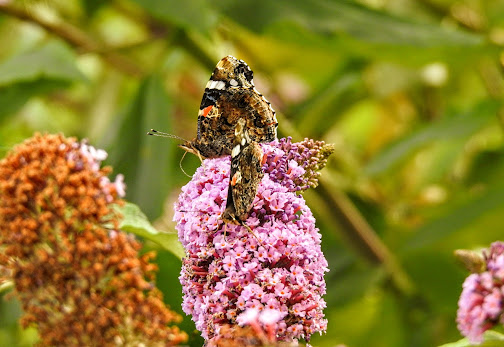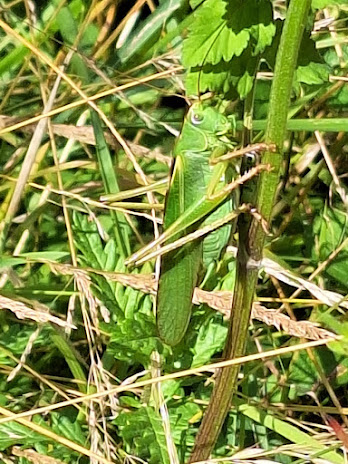Saturday 22nd July 2023.
My first Black Arches moth of the year near Andy's moth trap.
I knew rain was coming in from the west and so I had to make a decision on birding somewhere where it was going to be fairly dry. Blashford Lakes seemed the most logical answer as watching from the Hides there could produce some nice sightings, despite the weather. As it turned out, I actually got a ‘year-tick’ with a Ruddy Shelduck present on Ibsley Water and showed well at both the Tern Hide and later that morning, the Goosander Hide.
Above, this Privet Hawk-moth was in the moth box and below, my first White-spotted Pug of the year.
Also, my first Common Carpet of the year was present.
Beforehand, it was a check of Andy Fisher's moth box at Cowplain Marsh (his back garden!) where I picked up FIVE more excellent moths added to my year list. Pick of the bunch was a stunning Black Arches that was perched on the outside of the Conservatory window, where I had to use a ladder to grab some decent photos of the moth. A Privet Hawk-moth came very close to being the best moth as I found it sitting within the moth box as I quickly got a few nice photos of it perched on my hand. I then placed it carefully in one of the nearby Rose Bushes where it settled down and rested. Two more macros that were new for the year were a Common Carpet and a White-spotted Pug. The final moth was a micro, a Long-horned Flat Body (Carcina quercana) of which was nearly on the ceiling within the Conservatory therefore I could not get a decent photo.
Moths present this morning in Andy’s garden included the following:
- 1 Privet Hawk-moth (NFY)
- 1 Common Carpet (NFY)
- 1 Black Arches (NFY)
- 1 White-spotted Pug (NFY)
- 2 Double-striped Pug
- 1 Vines Rustic
- 3 Nut-tree Tussock
- 1 Single-dotted Wave
- 2 Uncertain
- 1 Common Rustic
- 6 Willow Beauty
- 1 Knot grass
- 1 Tree-lichen Beauty
- 6 Riband Wave
- 1 Common Plume
- 1 Long-horned Flat Body (NFY)
- 1 Olive Pyralid moth
- 1 Marsh Dowd
- 6 Rosy Tabby
The Ruddy Shelduck on Ibsley Water with an Egyptian Goose and a Coot for company.
After picking up Geoff Farwell, we made our way westbound along the M27 and then through the New Forest to Blashford Lakes. We encountered a few showers along the way and then it didn't take that long for the rain to set in for the day. We were going to spend the day watching from the superb hides here at Blashford and the birdlife did not disappoint either. From the car park by the Tern Hide, Sand Martins were flying low over our heads, a kind of prelude for things to come as the whole lake was alive with these beautiful little birds. Even a few Swifts and Swallows joined them, but it wasn't till we got to the Lapwing Hide that we saw a small flock of House Martins joining in with the other Hirundines. Geoff had never been on these Hides and he was most impressed with the set up here (a big pat on the back for the Management here).
One of the Common Sandpipers present today. I think there might have been up to 5 birds present on the reserve today.
From the Tern Hide, up to three Common Sandpipers gave superb views in front of the Hide, occasionally walking along the shoreline in front of us and were also joined by a family group of three Pied Wagtails, which included a juvenile bird. There were not many other passerines seen, though the Sand Martins entertained us throughout the morning.
Above, the juvenile and below, the adult male Pied Wagtails in front of the Tern Hide.
I had brought my scope with me and quickly got about checking and counting the birds around Ibsley Water that included a big count of at least 121+ Egyptian Geese, though from the other Hides, you could easily add another 30 birds to that number. Both Canada and Grey Lag Geese were present on the open water, though in much smaller numbers whereas other wildfowl included Tufted Duck, Mallard, Gadwall and hundreds of Coot. A sweep across Ibsley Water with my scope and I counted at least 43+ Great Crested Grebes from the Tern Hide, though I am sure there were many more around by the other Hides.
Above, one of many Egyptian Geese and a female Mallard in front of the Tern Hide. Below, a Sand Martin zooming past the Hide.
There were a few Common Terns present with at least three birds hunting over the water. One bird decided to perch right in front of the Hide and showed very well to us admirers as it had a quick preen and then off in search of small fish again. Geoff picked up the Ruddy Shelduck swimming west across the water near the ‘big stick’, but eventually disappeared behind the islands. It looked as though the rain had abated a little and so we decided to make our way to the Goosander Hide to see what was hiding around there.
Above, a Common Tern perched in front of the Tern Hide and below, another Sand Martin passing close by.
From the Goosander Hide, on opening one of the Hide windows, Andy had a confrontation with a Hornet, but though impressive, it soon flew off. I, however, had several Harvestman insects right in front of me when I opened up my window! We spent a good hour in the Hide where below us, the Sand Martin artificial nesting bank was still being used, with birds flying in and out of the nest holes. There are a few plants jutting out of the water for the birds to rest on, but the weather wasn't allowing them to do that.
Above, yet another Sand Martin and below, the Hornet on the Goosander Hide.
A female Grey Wagtail was searching for food near the Sand Martin area and a pair of Chiffchaffs were seen flitting about within the vegetation further along. Out on the water, Geoff picked out a drake Pochard swimming close to the edge of the island and further along, I found another three birds swimming near the point of the island among the many Tufted Duck and Egyptian Geese. Earlier this week, a female Goldeneye was reported back on Ibsley Water and I then found the bird near where Geoff found the first Pochard. A very early returning bird indeed.
Above, one of several Harvestmen on the Goosander Hide. Below, the Egyptian Goose was seen again from the same Hide.

Andy gave the shout that he had a raptor flying towards us and sure enough, it was our first Hobby sighting of the day and this bird looked as though it was on a mission too! It had obviously spotted something to attack and when the Sand Martins suddenly rose higher in the sky and gave off their alarm call, I think the Hobbies' attention was on them. A little later, another sighting of one heading south low over the area was had, though it really didn't hang around to linger. Earlier today, I did see from the Tern Hide, through the scope, a distant Lapwing on one of the islands to the north; so to see our next wader, an Oystercatcher flying low over the water, I quickly put the boys onto the bird to add to our day list of bird sightings. They bred successfully earlier in the year here, but there were no sightings of any Little Ringed Plovers today. I did pick up the Ruddy Shelduck again and this time showing a little better compared to our first sighting. It even popped out of the water briefly and rested on the edge of the island.

Above, the female Grey Wagtail with prey by the Sand Martin nesting holes. Below, the female Goldeneye was also in front of the Goosander Hide.
Our next stop was the Lapwing Hide and so we took the long way round along the footpaths despite the rain falling a little harder than before. On our way there, we had sightings of at least two juvenile Reed Warblers within the vegetation, both giving off their distinctive ‘churrs’. One of the screens overlooking a large lake that was nearly covered in weeds, held a large number of Mallard in eclipse plumage and also a Gadwall, but very little else.
The Pondskater, Aquarius paludum, where several were seen. These are the larger form of Pondskater in the UK. This individual, I assume a female, was breeding with this male on top in front of the Goosander Hide.
On reaching the Lapwing Hide, apart from the Egyptian Geese, Coots and Mallard; the only other bird of note here was a Common Sandpiper that eventually flew off south. More Hirundines came in to hawk for insects low over the water including a flock of House Martins, but it was relatively quiet here. So after about 30 minutes, I checked my watch and said to the guys it's time to make tracks for home.
Above, Fleabane was growing abundantly by the footpaths. Below, Egyptian Geese, Mallard and Coot in front of the Lapwing Hide.
Though the weather was poor, we had a good selection of birds to look at and for me to pick up a most unexpected ‘year-tick’, that was a bonus. But most of all, I kept good company today, which makes all the difference.



%20(1).jpg)






















~2-1.jpg)


















.JPG)



